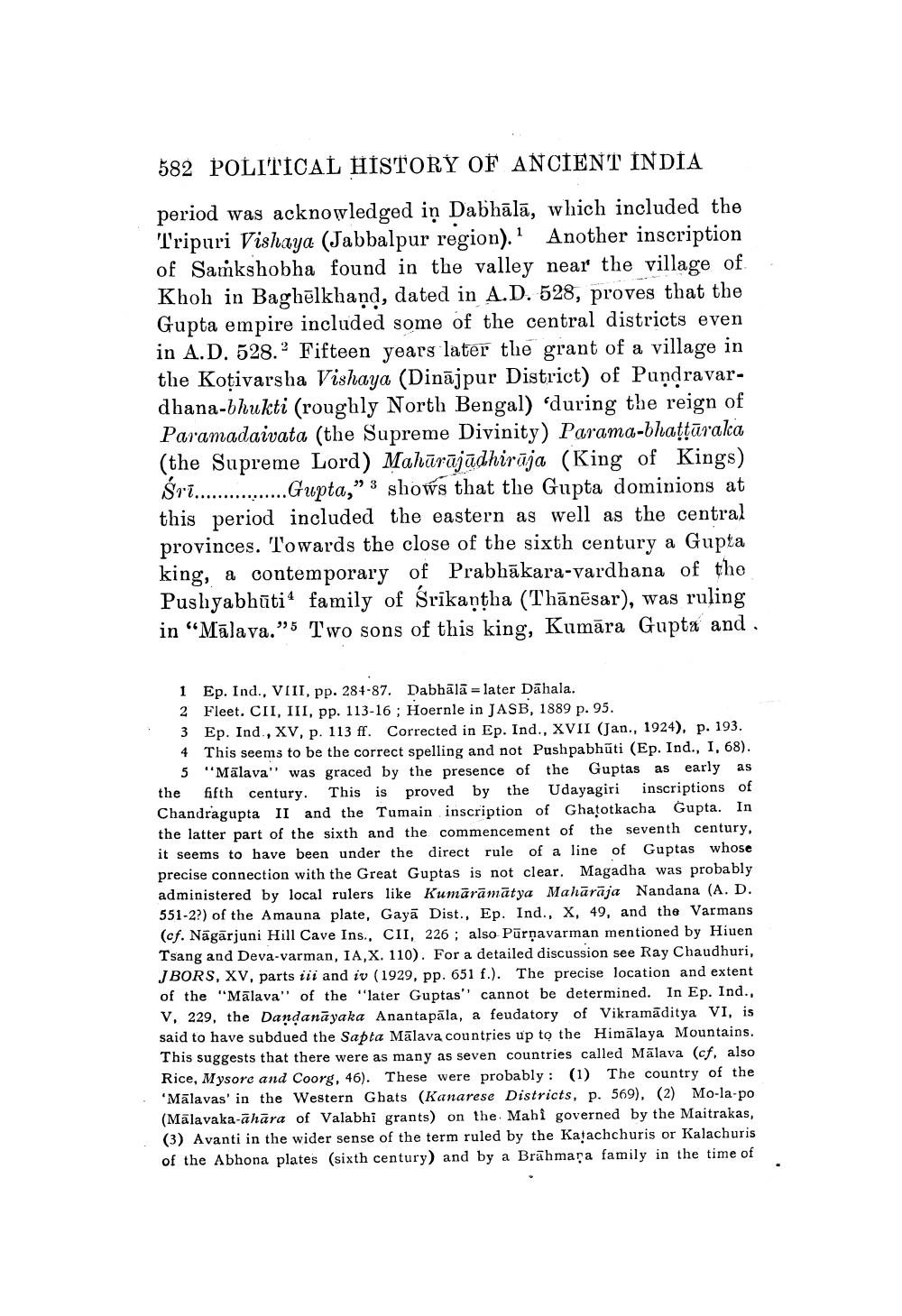________________
582 POLITICAL HISTORY OF ANCIENT INDIA
period was acknowledged iņ Dabhālā, which included the Tripuri Vishaya (Jabbalpur region). Another inscription of Samkshobha found in the valley near the village of Khoh in Baghēlkhand, dated in A.D. 528, proves that the Gupta empire included some of the central districts even in A.D. 528.2 Fifteen years later the grant of a village in the Koţivarsha Vishaya (Dinājpur District) of Pundravardhana-bhukti (roughly North Bengal) during the reign of Paramadaivata (the Supreme Divinity) Parama-blattūrala (the Supreme Lord) Mahūrājādhirāja (King of Kings) Sri................Gupta,” 3 shows that the Gupta dominions at this period included the eastern as well as the central provinces. Towards the close of the sixth century a Gupta king, a contemporary of Prabhākara-vardhana of the Pushyabhūti* family of Srikantha (Thānēsar), was ruling in "Mālava."5 Two sons of this king, Kumāra Gupta and .
1 Ep. Ind., VIII, pp. 281-87. Dabhālā = later Dāhala. 2 Fleet. CII, III, pp. 113-16; Hoernle in JASB, 1889 p. 95. 3 Ep. Ind., XV, p. 113 ff. Corrected in Ep. Ind., XVII (Jan., 1924), p. 193. 4 This seems to be the correct spelling and not Pushpabhūti (Ep. Ind., I, 68).
5 "Mālava" was graced by the presence of the Guptas as early as the fifth century. This is proved by the Udayagiri inscriptions of Chandragupta II and the Tumain inscription of Ghatotkacha Gupta. In the latter part of the sixth and the commencement of the seventh century. it seems to have been under the direct rule of a line of Guptas whose precise connection with the Great Guptas is not clear. Magadha was probably administered by local rulers like Kumārāmātya Mahārāja Nandana (A. D. 551-2?) of the Amauna plate, Gayā Dist., Ep. Ind., X, 49, and the Varmans (cf. Nāgārjuni Hill Cave Ins., CII, 226; also Pūrņavarman mentioned by Hiuen Tsang and Deva-varman, IA,X. 110). For a detailed discussion see Ray Chaudhuri, J BORS, XV, parts ili and iv (1929, pp. 651 f.). The precise location and extent of the "Mālava" of the later Guptas'' cannot be determined. In Ep. Ind., V, 229, the Dandanāyaka Anantapāla, a feudatory of Vikramaditya VI, is said to have subdued the Sapta Mālava countries up to the Himālaya Mountains. This suggests that there were as many as seven countries called Mälava (cf. also Rice, Mysore and Coorg, 46). These were probably : (1) The country of the 'Mālavas' in the Western Ghats (Kanarese Districts, p. 569). (2) Mo-la-po (Mālavaka-ahāra of Valabhi grants) on the Mahi governed by the Maitrakas, (3) Avanti in the wider sense of the term ruled by the Katachchuris or Kalachuris of the Abhona plates (sixth century) and by a Brāhmara family in the time of




